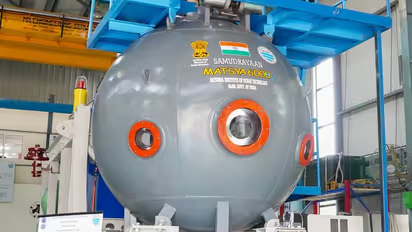After Chandrayaan, it's Samudrayaan: Scientists ready Matsya 6000 submersible for deep-sea exploration

Synopsis
Following the success of Chandrayaan-3, Indian scientists are preparing to conduct deep-sea exploration, Samudrayaan, with the Matsya 6000 submersible, aiming to search for valuable metals and minerals.
Indian scientists, following a successful lunar mission, Chandrayaan-3, are now gearing up for a deep-sea exploration endeavor known as project Samudrayaan. Their mission involves sending three individuals 6,000 meters underwater in an indigenously developed submersible to search for valuable metals and minerals, including cobalt, nickel, and manganese.
The submersible, named Matsya 6000, has been in the making for nearly two years and is scheduled to undergo its first sea trials in the Bay of Bengal, off the Chennai coast, in early 2024. This project gained added importance after the Titan submersible imploded while taking tourists to explore the Titanic wreckage in the North Atlantic Ocean in June 2023. As a result, scientists are meticulously scrutinizing Matsya 6000's design.
Scientists from the National Institute of Ocean Technology (NIOT), responsible for developing Matsya 6000, are conducting a comprehensive review of the submersible's design, materials, testing procedures, certification, redundancy measures, and standard operating protocols.
M Ravichandran, Secretary of the Ministry of Earth Sciences, told TOI, "Samudrayaan mission is underway as part of the Deep Ocean Mission. We will be conducting sea trials at 500 metres depth in the first quarter of 2024."
The mission is anticipated to be completed by 2026. It's worth noting that only a handful of countries, including the US, Russia, Japan, France, and China, have developed manned submersibles.
In addition to searching for valuable minerals such as nickel, cobalt, manganese, hydrothermal sulphides, and gas hydrates, Matsya 6000 will also investigate the chemosynthetic biodiversity present in hydrothermal vents and low-temperature methane seeps in the ocean.
G A Ramadass, the director of NIOT, mentioned that they have designed and constructed a 2.1-meter diameter sphere for Matsya 6000 to accommodate three individuals. This sphere will be constructed from an 80mm-thick titanium alloy to withstand the immense pressure of 600 bar (600 times greater than sea level pressure) at a depth of 6,000 meters. The submersible is designed to operate continuously for 12 to 16 hours, with a 96-hour oxygen supply.
"Except for the sphere, we have redundancy for everything. Sometimes double, sometimes triple redundancy. An official sea trial will be certified, and we have gone with DNV-GL for certification. We will also follow standard operating procedure such as deploying the submersible from a a ship, which will remain on the surface right above the submersible for easy communication with the underwater vehicle," explained the NIOT director to TOI.
Stay updated with the Breaking News Today and Latest News from across India and around the world. Get real-time updates, in-depth analysis, and comprehensive coverage of India News, World News, Indian Defence News, Kerala News, and Karnataka News. From politics to current affairs, follow every major story as it unfolds. Get real-time updates from IMD on major cities weather forecasts, including Rain alerts, Cyclone warnings, and temperature trends. Download the Asianet News Official App from the Android Play Store and iPhone App Store for accurate and timely news updates anytime, anywhere.